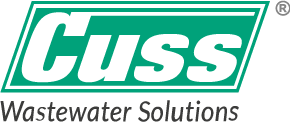Wastewater treatment plants for municipalities
In industrial plants, waste water of municipal structure often accumulates from the canteens and sanitary facilities of the production and office buildings. This can be treated separately to receiving water quality in specially designed and compact treatment systems.
One of the characteristics of municipal wastewater is the intermittent inflow into the treatment plant. Over the course of the day, inflow volumes vary greatly and can also differ in composition. In sewers where rainwater is mixed with domestic wastewater, these fluctuations are particularly large.
In addition to a high load of organic compounds, municipal wastewater often also contains comparably large amounts of coarse substances (waste, plant residues, sand). As a first step in wastewater treatment, the water is mechanically cleaned by a rake and the sand contained is separated. The dissolved organic substances are then biologically purified in an activated sludge tank. In order to comply with the limits for nitrogen, the stimulation of nitrification and denitrification is a standard practice in municipal wastewater treatment.
Fluctuations in wastewater quality and quantity are minimised by an equaliation basin that is installed upstream of the aeration basin. To prevent overfertilisation of the receiving water, the existing phosphorus is removed from the wastewater. Based on the targeted clear water quality, further technologies can be applied.

